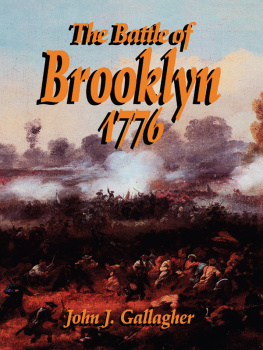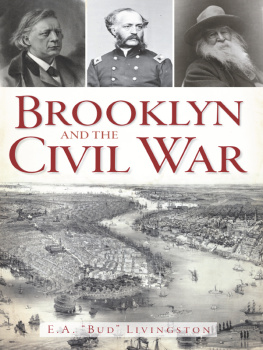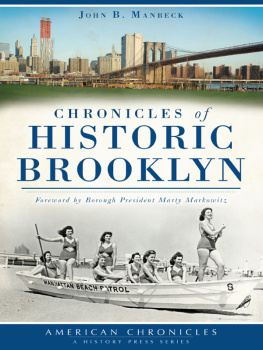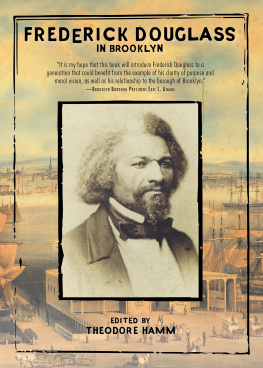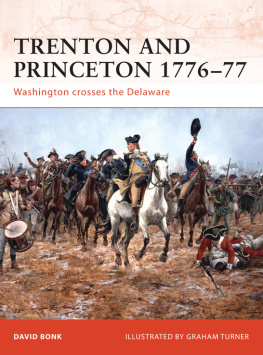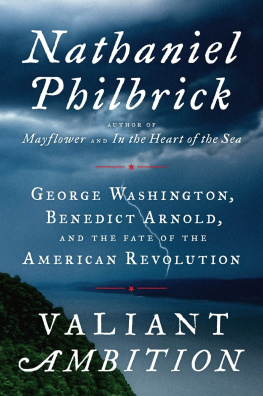Copyright 1995 by John J. Gallagher
All rights reserved. No part of this publication may be reproduced, stored in a retrieval system, or transmitted, in any form or by any means, electronic, mechanical, photocopying, recording or otherwise, without the prior permission of the publishers.
p. cm.
Includes bibliographical references and index.
ISBN 1-885119-02-X : $24.95
1. Long Island (N.Y.), Battle of, 1776. I. Title.
E241.L8G35 1995
973.332dc20 95-712
CIP
Preface
A T ONE TIME I might have concurred with the considerable number of people who have underestimated the Battle of Brooklyn as a seminal event in both American and Western history. In fact, more accurately, I was one of the even greater number who did not give The Battle of Long Island, as it has been called, much thought at all.
Because a Brooklyn historian requested that I lend a military history perspective to a lecture event that was to commemorate the battle, however, I found myself compelled to delve into the events of August 27, 1776. It quickly became apparent to me that the clash of main British and colonial forces in North America that day comprised not only a major event in the War of Independence, but marked an important transition in the history of warfare as well. With this battle, the days of the chivalric contest-cum-display staged by the monarchs of Europe had ended. With democratic principles having come into play, the nature of military conflict had shifted in an entirely new direction.
This is not to say that the fighting in Brooklyn causedan historic change in the behavior of nationsthough important lessons were learned that day. More to the point, the great clash in Brooklyn inaugurated a new age of warfare. The battle marked the first step, however tenuous, into the modern era of total war.
The military engagement that many historians call the Battle of Long Island was, naturally, fought there. Brooklyn as a borough was not yet in existence. But the battle should have had a more local nameindeed, earlier writers did call it The Battle of/at/for Brooklyn. Just as the Battle of Bunker Hill did not rage throughout Massachusetts, the battle staged in Brooklyn did not extend throughout Long Island. Although the area covered by the fighting was extensive for those timesat least twice that covered by the Battle of Waterloo, for examplethe fighting took place over not much more than half the area of todays Brooklyn. It all occurred in the space of one morning, and the concentration of combatand casualtieswould be surpassed by no other battle of the war.
The practice in Europe was to name a battle after the nearest major settlement. Waterloo was fought about one and a half miles south of Waterloo village, at La Haye Sainte. This was more or less the same distance from the settled part of the Town of Brooklyn where the major fighting took place: Flatbush Pass and the Old Stone House at Gowanus. Howes dispatch on the British victory was marked Long Islanda generality; Wellingtons was written at Waterloo.
In 1776, the eastern boundary of the Town of Brooklyn lay at the foot of the Flatbush Pass, marked by the Dongan Oak, which the Americans cut down during the fight to form a barrier across the Flatbush Road; the southern boundary was at todays 60th Street, almost a mile south of the watermelon patch where the first shots of the battle were fired. To the east, the township boundary encompassed the village of Bedford.
The historian Henry Stiles wrote in 1867: We have preferred to call this the Battle of Brooklyn, because that term more completely describes the locale of the battle which was fought entirely within the limits of the old town, now included in the present day city of Brooklyn. And Martha Bocke Flint wrote in 1895: Now began the stirring events of the week whose culminating action is recorded in history as the Battle of Long Island, a misnomer for what contemporary writing and tradition always call the Battle of Brooklyn. In 1951, the United States government legitimized the title when it issued a three-cent stamp, The Battle of Brooklyn, which depicted Washington mounted on a white horse, directing the action from atop a ridge.
Of what actually happened on August 27, 1776, I have tried to write as objective an account as I can. Original sources have been drawn upon whenever possible and I have done my best to be conscientious in citing references. I trust historians will not be too harsh with me should they find any lapse, and I also trust this book will prompt others to search for more information to fill in any blank spaces that still exist in the history of the battle.
The opinions stated in the book are my own or are identified as those of others whose names I mention. I have walked over the battlefield and the places mentioned, from the Rockaways to Willetts Point, to see whether the movements were possible in the times mentioned by other authors. I have noted the appearance of the sites, measured the distances and elevations and taken into account previous observations, to describe what I see as the geographic actualities of the battle.
There are other accounts of the battle that cite numbers, dates, troop movements and heroic acts with an admirable attention to detail. I have also tried to tell the larger story. What follows is a case history designed to illustrate the theory that the face of warfare changed suddenly during those few hours on a summer day over 200 years ago. The first battle fought by the first modern democracy may have resulted in a defeat for its citizen-soldiers, but their valiant effort signaled the beginning of the end of an old European order and the start of the age of the Rights of Man.
Foreword
O N A WALK THROUGH Brooklyn on a hot August day, anybodys imagination would be stretched trying to visualize another summer day over two hundred years ago, when tens of thousands of soldiers fought to decide the fate of America. On August 27, 1776, a crucial battle of the Revolutionary War was fought on Brooklyns soil, nearly resulting in the decisive defeat of George Washingtons Continental Army. Both the professional soldiers of the Old World and the citizen soldiers of the New marched, fought and died through the present-day neighborhoods of Bedford-Stuyvesant, Crown Heights, Fort Greene, Flatbush, Park Slope, Cobble Hill and others, as well as in what are now Prospect Park and Green-Wood Cemetery.
Historians have long been interested not only in remembering battles, but in noting how and why they have been commemorated. The wars and battles a culture retains and embroiders in its popular imagination are no more revealing than those that are neglected or forgotten. In sharp contrast to the hundreds of monuments and elaborate interpretive displays at, for example, Gettysburg and Valley Forge, the battlefield of Brooklyn is marked only by a few modest physical reminders. Battles and battlefields become part of our national heritage because people wish to pay tribute to martial courage and perpetuate a sense of connection to the living past. The Battle of Brooklyn, however, seems to have disappeared long ago from our nations consciousness.

